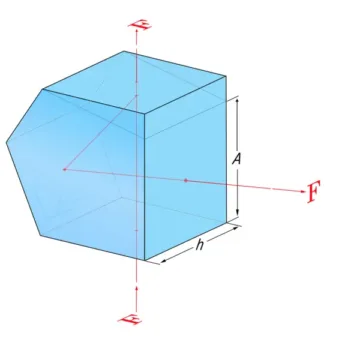-
AG glass Windows is used on-screen to reduce sunlight/light reflection. The surface is etched by chemical to specified gloss, roughness and haze. A finished window might need post-treatment such as silk-screen printing, 3M double sides adhesive, heat tempered, coating. Please contact us for more information, supports or free samples.
-
A special type of thick biconvex optical lens is a Ball lenses that usually has a sphere geometric shape. These are made of a single material such as BK7 or other optical glass/Fused Silica/CaF2 which is a commonly used material for ball lenses. The smallest lens we produced is < 0.5 mm. We can process ball lenses using all types of glass material. Our price for PV industry may be as low as USD0.02/pcs. We are developing CSD-based AR-coating to provide a low-cost PV-coating solution.
-
Beamsplitter Penta Prism is produced by bringing together a precision Penta Prism and a wedge prism and adding an appropriate interference coating to one of the typically reflective surfaces. Since minor motions of a Penta Prism do not influence the true right angle at which light rays are reflected, the difference between the light rays transmitted and reflected is highly controllable
-
- Z-OPTICS has big catalog of cylindrical lens off-the-shelf for quick delivery and provides quick sampling service for new drawings.
- Multiplicity of materials, Glass, Fused Silica, Sapphire, CaF2, ZnSe ….
- Innovative low cost plano convex cylindrical lens is available.
Overview
- Ready Stock: Z-Optics offers a large catalog of cylindrical lenses available for fast delivery and custom sampling for your unique designs.
- Material Multiplicity: Select from premium optical glass, fused silica, sapphire, CaF2, ZnSe, and more—a solution for every requirement.
- Cost-Effective Options: Innovative low-cost plano convex cylindrical lenses and specialized shapes for demanding optical applications.
-
Dove prisms are reflective prisms that are used to invert images. A truncated right-angle prism is used to build dove prisms. Roof prisms are commonly used in optical equipment like digital optoelectric products, imaging equipment, fingerprint systems, medical devices, precise digital control machinery and other optical fields, common science educational equipment, optical communication, etc.
-
All sides of an Equilateral Prism are the same length. This also implies that they have three 60-degree angles. They are beneficial in wavelength separation applications. They are also often used to refract light. This refraction demonstrates that white light is a blend of all the colours in the spectrum.
-
Fused Silica Windows are an excellent choice for high-precision, clear transmittance applications. They have low bulk scatter and autofluorescence, as well as incredibly high surface quality and parallelism. Many sectors use fused silica windows, including aircraft, astronomy, military and commercial avionics, medical and scientific instruments, academics and research, and industrial uses. They're an excellent choice for laser applications, spectroscopy, photolithography, vacuum windows, and a variety of other uses. Discover premium Fused Silica Windows from z optics . 0.1 angstrom roughness can be achieved with super polishing.
-
A Germanium Window is an optical window that is opaque to UV and visible light but transmits a wide range of infrared radiation. Because of its low dispersion, it exhibits little chromatic aberration. Germanium is also a material commonly for IR windows and lenses in thermal imaging systems. Features -
- Excellent for near-infrared and imaging applications.
- Anti-reflection coating with a wavelength range of 8 to 12 µm.
- This Window is ideal for low-power CO2 laser applications.
-
A Penta Prism is a five-sided reflective prism used to scatter a light beam by 90 °. The beam reflects twice inside the prism, allowing an image to be transmitted through a right angle without inverting it (i.e., without altering the handiness of the image) as an ordinary right-angle prism would. For optimum performance in the ultraviolet (UV), visible, or infrared (IR) spectrums, z-optics provides a selection of Penta Prisms. In addition, we provide half Penta prism. Without flipping or reversing the image, it is used to shift the line of sight by 45°. It is frequently used in telescopes and also has uses in geodesy, microscope tubes, projection and image systems, and Penta prism, half-Penta prism, and precision prism are all products that we manufacture in China. Please get in touch with us directly for pricing information or details on prisms that might work for your application.
-
The Rhomboid Prism is a parallelogram with uneven length neighbouring sides and non-right angled angles. Rhomboid prisms are frequently used to dispense a laser beam while maintaining its direction. Rhomboid prisms will shift the optical axis in imaging applications without inverting the picture. They have high tolerance angles, which ensure that the output beam is parallel to the input beam within 30 arcseconds. Features - 1. Lateral Beam Displacement. 2. Parallel Input and Output Beams to 30 Arcseconds. 3. Repositions the optical axis without inverting the image. 4. Exceptionally well-suited for severe displacement applications.
-
A roof prism is a transparent optical marvel that comprises a segment where two faces meet at an angle of 90°, resembling the roof of a house and inspiring the name of this exceptional feature. This unique design allows the reflection of the two 90° faces to return an image that is laterally flipped around the axis where the faces meet, ensuring top-notch image inversion and precise orientation adjustments.
-
The mechanical properties of Sapphire include its great strength, thermal stability, wear resistance, and chemical inertness. As a result, a Sapphire Window outperforms other optical materials in severe conditions, acting as a shield between the elements. In optical and mechanical applications, sapphire windows are often used. Features
- Chemical resistance due to its high surface hardness.
- Transmits light at wavelengths ranging from ultraviolet to near-infrared.
- Thinner and stronger than standard glass windows.
- Available with anti-reflection coatings ranging from 400 to 5000nm












